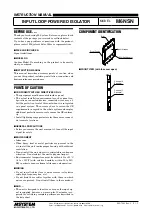
SunTouch TapeMat Installation Manual
11
STEP 4.5:
Secure the Mat to the Floor
After test-fitting the mat and deciding what technique
will be used to help fill any odd spaces, carefully cut the mesh
where needed.
Lay the mat down flat. Ensure it fits well and has no folds or
large ripples.
IMPORTANT: Securing the mat as flat as possible will help
make a smooth surface for spreading mortar.
Begin removing the liner from the double-sided tape along
one mat edge and press the tape down, ensuring the mat
lays flat.
Remove the liner from the double-sided tape along the
other mat edge and press the tape down. Pull on the mat as
needed to ensure it is flat as possible but be careful not to
pull the tape loose.
If an area of mesh does not lay flat enough, use a length of
the double-sided tape supplied in the Installation Kit, hot-
glue, or pneumatically applied staples to help. This may be
necessary at the ends of the mat. If staples are used, 3/8" x
1/4" chisel type are recommended. Do not staple closer than
1/4" (7 mm) from the heating wire. Be very careful not to
damage the heating wire.
DO NOT
staple or apply tape over the heating wire. Damage
can result.
DO NOT
use nails, duct tape, other types of tape, or other
unapproved fasteners to hold the heating wire or
mesh in place. Damage can result.
STEP 4.6
Use a digital multi-meter to measure the resistance between
the conductors of the power leads again. Record these
resistances in
Table 4
under “After mat is secured in place”.
STEP 4.7
Connect the LoudMouth to the TapeMat power lead. If
multiple mats are used, connect them to the LoudMouth in
series (white-to-black). Only one white, black, and ground
lead should be connected to the LoudMouth. Refer to the
Appendix for control and LoudMouth wiring diagrams.
STEP 4.8
Feed the power leads through the conduit to the control
electrical box, leaving at least 6"-8" of free power lead. Chisel
a slot in the floor to recess the factory splice level with the
heating wire. Secure the factory splice with hot glue so it
cannot be pulled into the conduit.
It may be necessary to use a metal nail plate to protect the
power lead and sensor wire as they transition into the wall.
This will help prevent nail penetrations from drywall and
baseboards trim.
Chisel a path for the power lead and factory splice. Use hot glue
to secure to the floor. Place a metal nail plate over the transition
point to protect the power lead and sensor wire.
Power Lead/
Heating Wire
Connection
Nail
Plate
Floor
Sensor










































